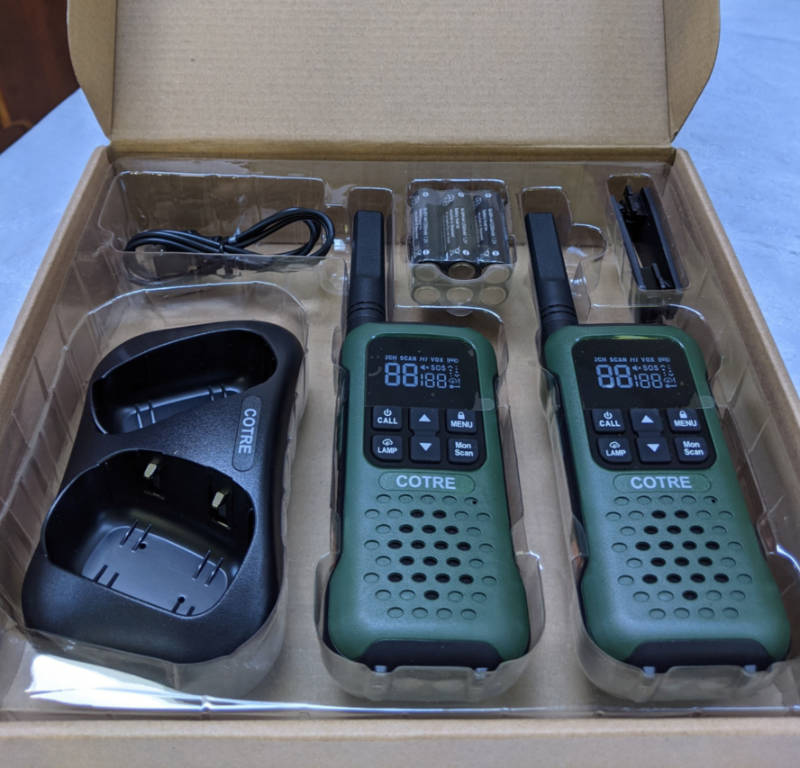
REVIEW – Who needs two-way radios when we all have cellphones? A powerful radio could move from convenience to necessity if cell signals don’t exist when camping or hiking for example. Hopefully, this review will help you sort the issues before you take the first radio set you see on a hanger in a sporting goods department.
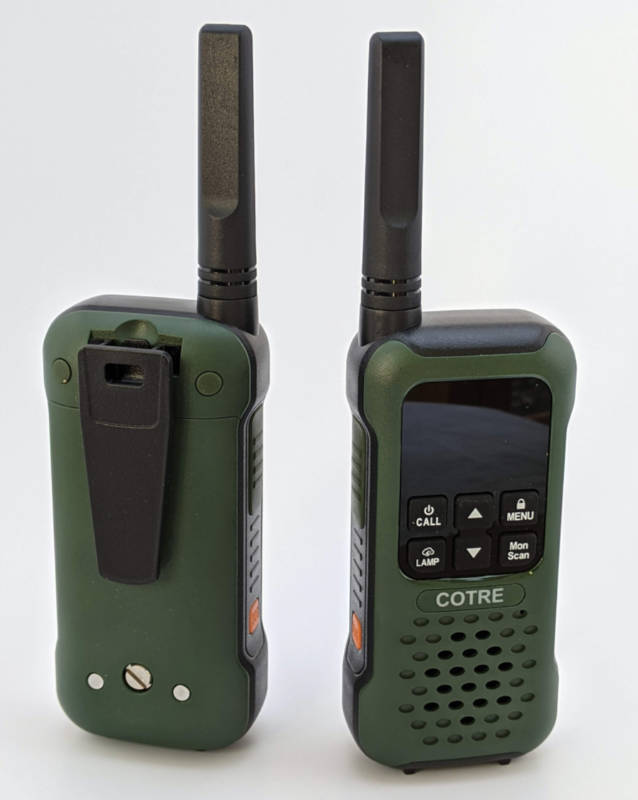
What is it
The COTRE Swan two-way radios are portable, hand-held, rechargeable, ‘walkie-talkie’ style radios operating at 2 watts or ½ watt selectable power, on the FRS (Family Radio Service) UHF frequencies.
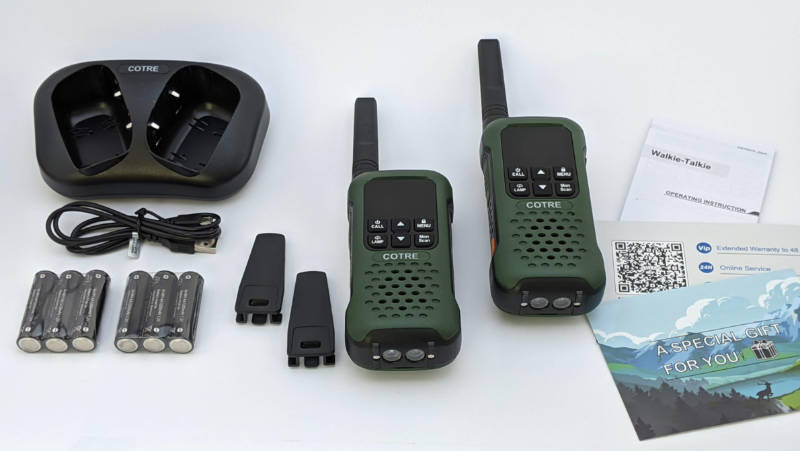
What’s in the box
- Two COTRE Swan radios
- One Charging Base (charges two radios simultaneously)
- One charging cord: USB-A to micro-USB (no AC charger)
- Two belt clips
- Six AA size, NiMh rechargeable batteries
- Manual sheet
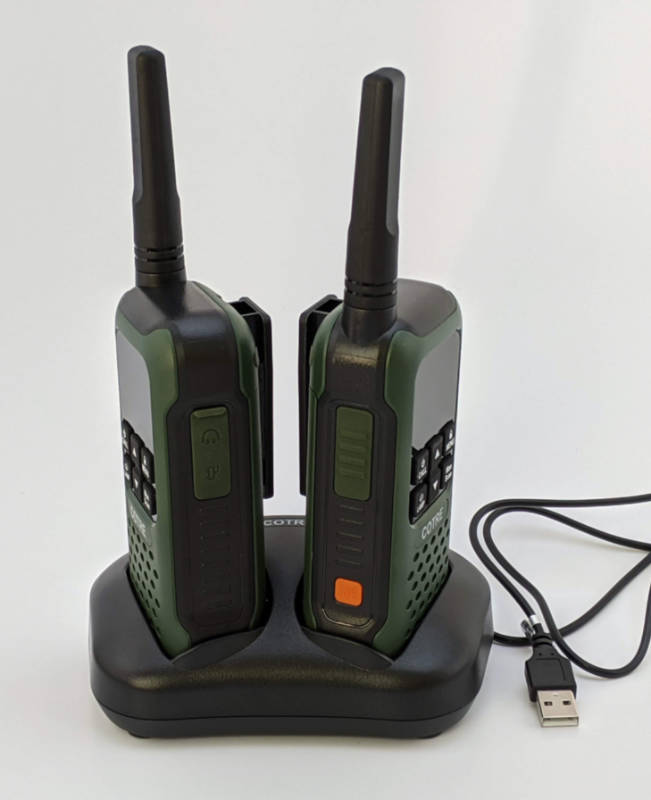
Hardware specs
- Color: Army green
- Number of channels: 22
- Privacy codes: 121
- Batteries: 6 AA NiMh rechargeable, 3 per radio
- Tuner technology: UHF
- Frequencies: FRS (Family Radio Service, U.S.A.)
- Operating temperature: 14 to 122 Degrees F
- Water resistance: IP67 (“waterproof” claimed)
- Maximum talk range: 32 miles (claimed)
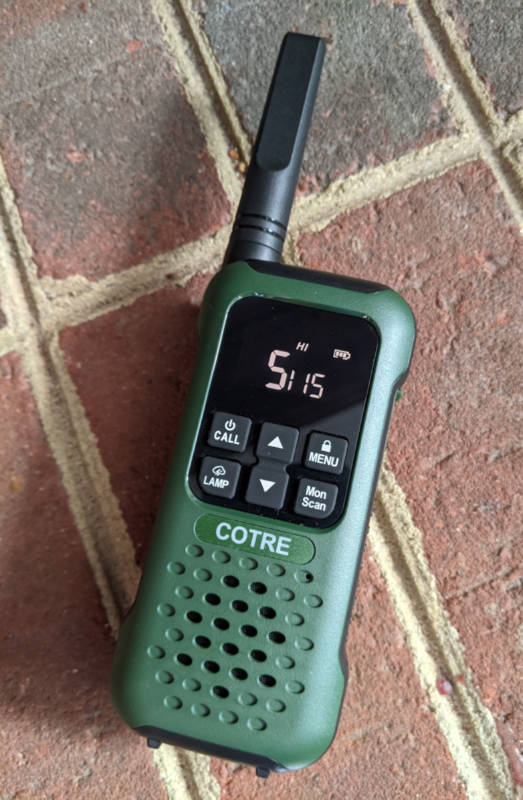
Design and features
FRS Frequencies
The COTRE radios operate on the U.S. FRS (Family Radio Service) frequencies.
Here is a link to the Federal Communications Commission’s page on the FRS. https://www.fcc.gov/wireless/bureau-divisions/mobility-division/family-radio-service-frs
Here’s what FCC says about the FRS:
“The Family Radio Service (FRS) is a private, two-way, short-distance voice and data communications service for facilitating family and group activities. The most common use for FRS channels is short-distance, two-way voice communications using small hand-held radios that are similar to walkie-talkies.
Other services that allow similar communications include the General Mobile Radio Service (GMRS) and the Multi-Use Radio Service (MURS).
The FRS is authorized 22 channels in the 462 MHz and 467 MHz range, all of which are shared with GMRS.”
These radios could be denied entry to some countries, so check before you travel with FRS radios.
Privacy Codes
These radios can be set to any of 121 privacy codes per channel, so if others are communicating on the same channel as you, they won’t hear your conversation unless they are also on your privacy code. Stated differently, there is a 1 in 22 chance someone will be on the same channel as you, then a 1 in 121 chance they would choose the same privacy code as you. So for someone else to be on, say, channel 15, privacy code 37 within a 2-3 mile range of you, it isn’t impossible but is quite unlikely.
Call Tone and ‘Roger’ tone
The radio has 20 different call tones. With this feature, a tone can be transmitted to the other radio to get the operator’s attention. Think of it as a radio ringtone. The roger tone is a short tone at the end of each voice transmission which indicates to the other operator your transmission has ended. Both of these tones are more audible alerts than is voice alone.
Red light SOS flasher
Oddly, SOS is not mentioned in the manual. SOS is activated by a press on the orange SOS button on the left side of the radio. The red LED flashes SOS in morse code.
NOAA Weather channels
The National Weather Service has transmitters across the United States that broadcast forecasts, watches, and warnings 24 hours a day. All six National Weather Service weather channels are built into the COTRE Swan. If the radio is in range of a weather service transmission it can be set for listening to Weather Service broadcasts or to receive weather alerts. The radio remains silent until a weather alert is broadcast, at which time an alert tone is sounded.
White LED flashlight
The light is on the bottom of the radio.
Floating LED light indicator
The light is on the bottom of the radio. This radio is designed to float the antenna down in the water and the white light will illuminate.
Installation and Setup
Install the batteries, then the belt clips if desired, plug the micro-USB end of the charging cord into the charging cradle, plug the USB-A end of the cord into a charger, add some AC current, and await the radios to be fully changed. During charging, when the radio’s Menu button is pushed a battery symbol at the top right of the screen flashes. When that symbol is steady and not flashing, the batteries are fully charged.
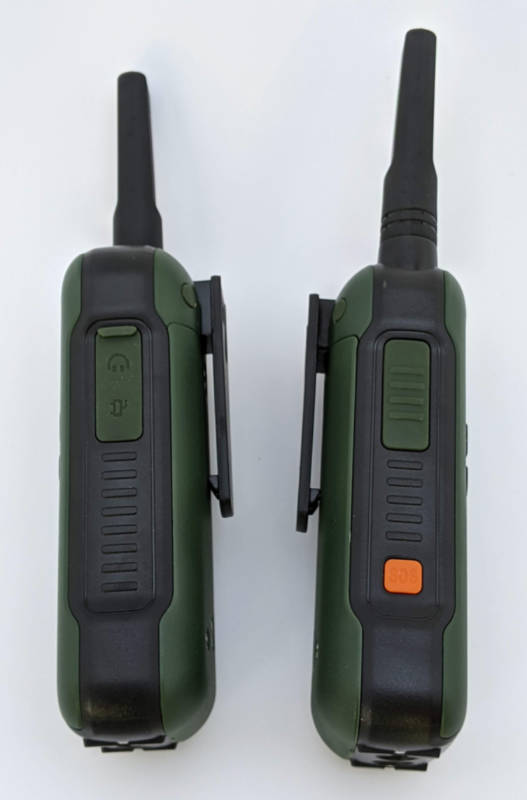
Do you need a license to use these radios? Not anymore. The FCC site says, “FRS is licensed by rule. This means an individual license is not required to operate an FRS radio provided you comply with the rules. You may operate an FRS radio regardless of your age, and for personal or for business use if you are not a representative of a foreign government.”
I hereby declare I am not a foreign agent, so I proceeded to test the COTRE radios.
Testing and observations
What could be more subjective than cell company coverage maps and TV antenna mileage claims? Answer: Radio manufacturers touting the communication range of their products. 32 miles and not 31? How was that tested and verified? How about 3 miles? But who would buy that radio?
The few times I’ve purchased two-way radios I’ve used the mileage claims only as a vague guide to potential and certainly not a guarantee. If one radio claims 32 miles and another claims 10 miles, that prompts me to check the output power of both. One would expect the higher claim to be on the more powerful radio but it’s just marketing lingo. Read carefully before buying.
What affects radio signals of any type? The main issues are transmission power (‘strength’ of the radio’s output usually expressed as watts), distance, antenna height, building construction (if you’re indoors or there are buildings between the 2 radios), terrain, obstructions, and to a degree, weather. (To a ‘degree’?) Weather effects come mainly from precipitation, lightning, and wind moving trees which can cause signal disruption.
I tested the line of sight communication range of these radios and used them in my residential neighborhood. I also checked the car-to-car range on the highway and city streets.

2 watts of UHF signal is good for about ½ mile in a residential neighborhood. That has been my experience with my first FRS radios 17 years ago (I still have those great Motorolas) and with these COTRE radios today.
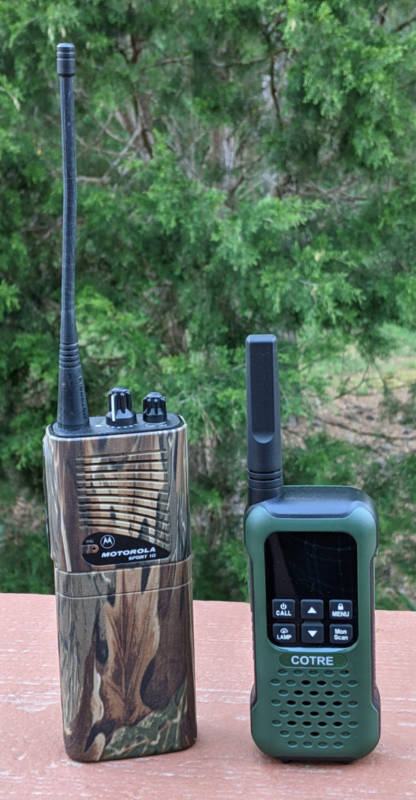
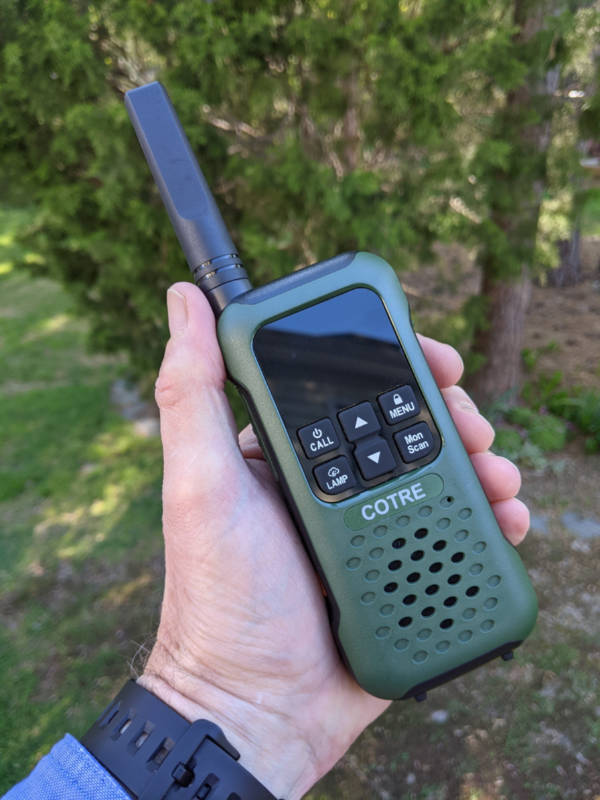
I went off on my bike to take a package to a shipping store a mile away by road. At the entrance to my neighborhood, which is exactly ½ mile from my abode, my wifely unit could hear me ok but we were both hearing some hiss, fade, and static as we talked. That’s an indication we were near the edge of the effective range of these radios. ½ mile it was. True, unimpeded, line of sight use would surely yield a better performance, but this is a practical test. How often does one need a radio only for straight line of sight, with no obstructions?
When I got to my destination I used the radio’s call tone to get my wife’s attention. She answered but we could barely communicate by voice. Our voices were weak and barely broke squelch (‘came through’ to the other radio). Per Google Maps we were 4000 feet apart, or about 3/4 of a mile.
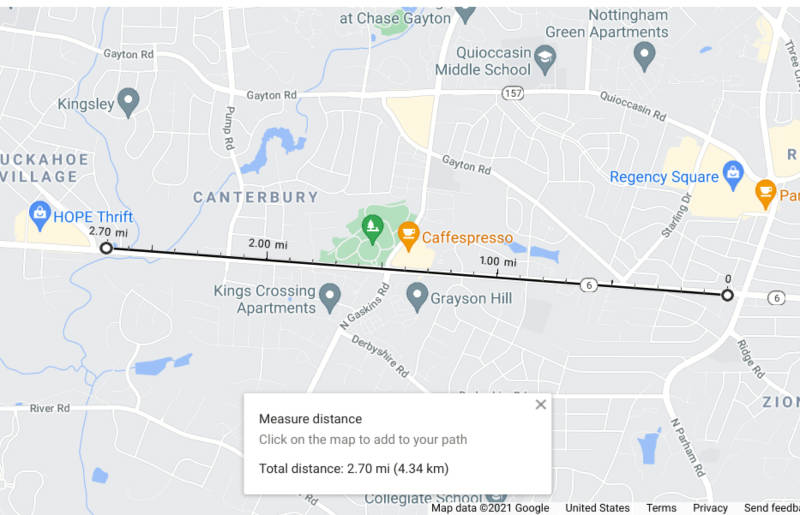
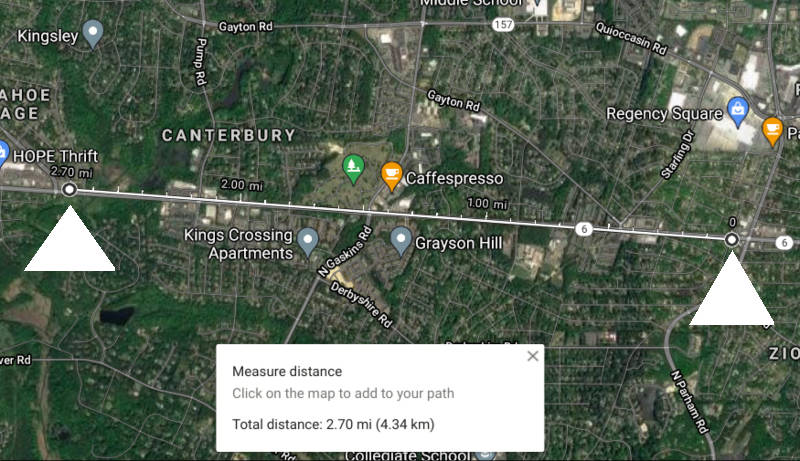
A friend and I thought of the longest straight line roadway in our area that was not an interstate and we settled on a great choice, pictured above. One can see about 3 miles, unobstructed, from hill-crest to hill-crest of this roadway.
We set the COTRE radios to the same channel. FRS channel 15 has the lowest frequency so call that a cheat if you must, since lower frequencies generally have greater range. We confirmed the setting for 2 watts/high power on both units, drove apart, then placed ourselves on foot at a couple of points along this roadway, transmitted back and forth several times each, and later measured our distance using Google Maps.
2.7 miles was about the limit of the useful communication range of these radios. Not 32, 25 or 5 miles, but a bit under 3 miles was the best we could do for this straight line test.
Car to car performance was best at under ¾ of a mile.
Here’s what bugs me: The claim of “Up to 32 miles”. Why not say ‘Up to 1000 miles’? That would be just as true. Even the claim of “3 miles in town” is unlikely unless you worked like we did to be exactly in a line of sight orientation.
I only achieved 2.7 miles transmission and reception performance on a straight roadway, and ½ mile in a wood frame residential neighborhood. Maybe they meant to put a decimal between the 3 and the 2 of that 32 mile claim?
What I like
- Solid, tight construction and professional ‘feel’ to these radios
- Clear logic to the button functions
- The full range of FRS channels and privacy codes
- Rechargeable NiMH batteries
- Alkaline AA batteries can be used (but take out a home equity loan)
- Excellent volume and speaker tone.
- Silent monitoring of the weather radio, with the alert function is a valuable feature.
What I’d change
- Be honest about the performance claims – this builds good customer relations, and would minimize product returns.
- The LCD screen needs to be brighter for outdoor visibility. The screens are hard to see outdoors even in overcast conditions.
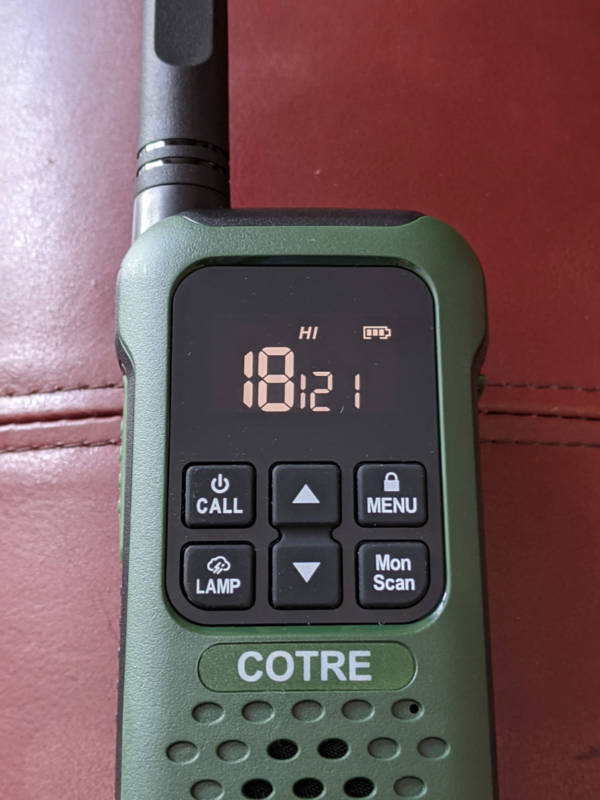
Final thoughts
The COTRE FRS radios are at a very good price for two radios of this build quality and number of features. My ultimate test result – I would personally buy these radios. Just be aware that you can count on these radios for 1/2 to 3/4 mile of reliable range in neighborhoods or dense woods. And that will be likely for any 2 watt FRS radios you consider.
Update 5/12/21
We’ve had some great comments to this review. Thank you all. You’ve prompted me to provide some additional information.
Privacy Codes
I stand corrupted about the privacy codes. Privacy codes do not encrypt your communications. Anyone in range of you on the same channel, who is not using privacy codes, will hear your transmissions. Privacy codes limit what comes over your speaker. This could be a very useful feature at times when you only want to hear from others in your group, but privacy codes are not encryption codes.
Range
Good points were made about FRS radio range in urban environments. Even though my 2.7 mile test was line of sight, it was very likely affected by interfering factors that would not be present in a ‘mountaintop to mountaintop’ setting, at sea, or on a deserted beach. Those are probably the least likely use scenarios for which these radios are purchased.
Licensing
I called the FCC Licensing Support Center to ask if a license is required for dual operation FRS/GMRS radios that operate at 2 watts maximum power. It turns out if a FRS radio operates on channels 15-22 at all, a GMRS license is required.
You and I are responsible to obey the laws and FCC rules. I leave compliance to you. You may benefit from a direct conversation with the FCC.
News: The agent told me the GMRS license is currently $70 but is expected to drop to $35 in the near future.
Here’s the entire article the FCC Support Agent sent. Note that business use is approved.
Family Radio Service (FRS)
Family Radio Service (FRS) is one of the Personal Radio Services. It is used by family, friends and associates to communicate within a neighborhood and while on group outings and has a communications range of less than one mile. You cannot make a telephone call with an FRS unit. You may use your FRS unit for business-related communications. You may use any of the 22 FRS channels on a “shared” basis. No FRS channel is assigned to any specific individual or organization.
No license is needed or issued. There is no age or citizenship requirement.
FRS radios have a maximum of 0.5 watt (500 milliwatt) effective radiated power (ERP) on channels 8-14, 2 watt ERP on channels 1-7 and 15-22, and integral (non-detachable) antennas. If your dual FRS/GMRS radio is capable of operating with an ERP exceeding the FRS limits or on GMRS only frequencies, it is considered a GMRS device and an individual GMRS license is required.
The rules for the Personal Radio Services are published in the Code of Federal Regulations, Title 47, Telecommunications, Part 95. The rules for the Family Radio Service are published in 47 CFR Part 95, Subpart B.
For more information regarding the Family Radio Service (FRS), please visit:
FRS – https://www.fcc.gov/wireless/bureau-divisions/mobility-division/family-radio-service-frs
Guide – https://www.fcc.gov/consumers/guides/personal-radio-services-prs-keeping-touch
Frequently Asked Questions:
Do I need a license to operate FRS radios?
FRS is licensed by rule. This means an individual license is not required to operate an FRS radio provided you comply with the rules. You may operate an FRS radio regardless of your age, and for personal or for business use if you are not a representative of a foreign government.
Do I need a license to operate a dual FRS/GMRS Radio?
Some manufacturers received approval to market radios that were certified under both FRS and GMRS, which allowed users to use one device to operate on FRS channels, which does not require a license, and GMRS, which requires an FCC license. In 2017, the FCC changed its rules to stop equipment authorization of FRS dual-service radios and it changed the rules for both FRS and GMRS such that existing radios would be reclassified as either FRS or GMRS to remove the confusion of whether a license was needed for legal operation.
Specifically, if you have a radio that was sold as a dual-service FRS/GMRS radio and it is limited to the channels and power limits provided under the FRS rules, then that device can be operated as an FRS device without a licensing requirement. However, if the device exceeds the limits under the FRS rules or includes any of the following channels (467.5500, 467.5750, 467.6000, 467.6250, 467.6500, 467.6750, 467.7000, and 467.7250 MHz), then it is a GMRS device and an individual FCC license is needed to operate the device.
Do I need a license to operate a dual FRS/GMRS Radio if I am only using the FRS channels?
There are no longer FRS only channels. All channels are shared with GMRS. The licensing requirements for dual use radios are below.
No – If you have a radio that was sold as a dual service FRS/GMRS radio and it is limited to the channels and power limits above, then the device can be operated as an FRS device without a licensing requirement.
Yes – If the device exceeds the ERP limits listed above or includes any of the following GMRS only channels (467.5500, 467.5750, 467.6000, 467.6250, 467.6500, 467.6750, 467.7000, and 467.7250 MHz), then it is a GMRS device and an individual FCC license is needed to operate the device.
Are my communications required to be in English?
There are no provisions in the Rules that require communications to be in English for FRS radios.
Additional Information:
You may operate your FRS unit within the territorial limits of the fifty United States, the District of Columbia, and the Caribbean and Pacific Insular areas (U.S.). You may also operate your FRS unit on or over any other area of the world, except within the territorial limits of areas where radio communications are regulated by another agency of the U.S. or within the territorial limits of any foreign government.
If you have any further questions or need additional information, please submit a help request at https://www.fcc.gov/wireless/available-support-services or call the FCC Licensing Support Center at (877) 480-3201.
Sincerely,
FCC Licensing Support Center
8:00 AM – 6:00 PM EST, M – F
Price: $69.99
Where to buy: Amazon
Source: The sample for this review was provided by COTRE.



Gadgeteer Comment Policy - Please read before commenting
Should have tried the middle and higher frequencies, also. Sometimes, issues with antenna resonance can make a big difference in range. These short antennas may have better resonance at middle or higher frequencies. Power output can also vary widely on some radios, depending on frequency used.
These radios seem okay. I see nothing to make them noticeably better than similar products and brands on the market. One thing I dislike is use of buttons and menus instead of a volume control. There may be times and situations where you want to raise, lower, or instantly silence, the receive volume. At those times, a push button volume is exceedingly slow. One gripe I have with many such radios that do have a knob volume control, is that the knob too easily rotates, say, if your coat or jacket contacts it. This can cause it to be way louder or weaker than you intended, making you miss a call or alerting persons or animals to your presence that you did not want alerted. A sturdy, replaceable, rubber washer or grommet fitted by the manufacturer to add resistance to the turning of the knob would fix this problem. Sadly, I am unaware of any manufacturer of FRS radios who includes such a desireable feature.
Excellent review; well researched. If you figure normal walking speed at 3 miles/hour then these radios only give a useable distance of a 10 minute walk, which doesn’t seem too useful. (Compare with how far your voice carries when yelling.)
Are there consumer radios that have better distance?
Yes. Radios that operate on the MURS band. With them you can replace the antenna, add an external one.
GMRS is better still – requires a no-exam license and can access repeaters, greatly increasing range. GMRS mobile units with 50 watt amps are cheap off eBay.
There are numerous propagation factors regrarding FM radios. The most important is line-of-sight between both radios. Secondly is what’s known as the noise floor and a term that reflects the signal to noise ratio. Being away from the city or urban environment would reduce the noise floor, that is random interference from other electrical devices and yes other radio systems. That in itself will increase the range of these radios. If one were to find a couple of mountains where you could position yourselves to have line-of-sight visibility between them 20-30+ mile range is not outside the range of possibility. The point made about antennas is a key factor as well. FCC rules prohibit any change to antennas on these radios so some experimentation would be beneficial to see what frequency works best.
If you know an experienced amateur radio operator link up and find the channel that works best. Find the distance where your transmission begins to get noisey. Change the channel on both radios and note which channel has less noise. That will be the channel to use.
One common misconception is that privacy codes prevent others from hearing you. They do not. They only prevent you from hearing others not using the same privacy code. If they’re not using privacy codes, they’ll be able to hear you just fine.
Riger beeps are irratsting to others on the samr channel. Dont use them!
If you operate on the channels capable of using the 2 watt power, a license is required. Read the Federal regs . Using these frequency band radios in a business is illegal. Business use tequires a license or use of the MURS band radios.
*Using these frequency band radios in a business is illegal.*
This is simply not true. They absolutely can be used by a commercial business.
Julie just posted an update I’ve written at the end of the article if the current commenters would like to check it out. Thanks for reading!
Whether you are camping in a forest or organizing an outdoor event, it is good to have the best GMRS radio. Thank you for review it.